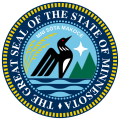| |||||||||||||||||||||
| |||||||||||||||||||||
| |||||||||||||||||||||
| Elections in Minnesota |
|---|
 |
The 1888 Minnesota lieutenant gubernatorial election was held on November 6, 1888, in order to elect the lieutenant governor of Minnesota. Republican nominee and incumbent lieutenant governor Albert E. Rice defeated Democratic nominee and former member of the Minnesota Senate Daniel Buck, Prohibition nominee Theodore S. Reimstad and Union Labor nominee Milan N. Pond. [1]


